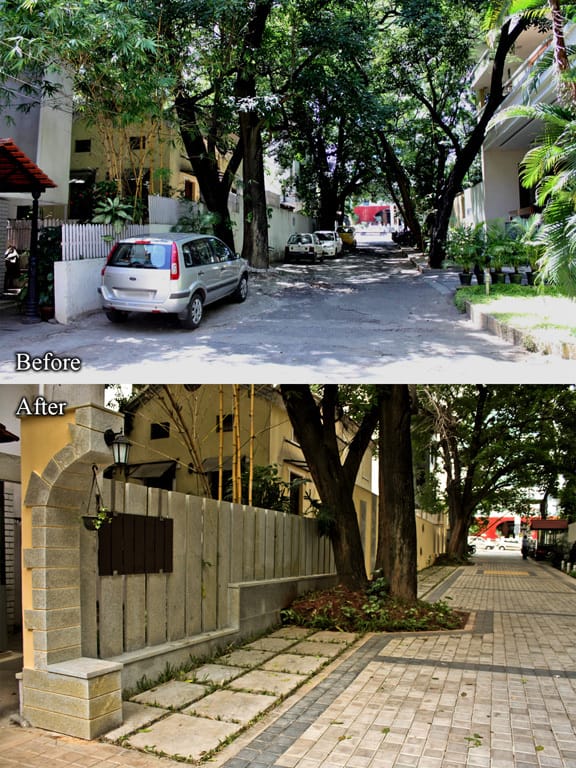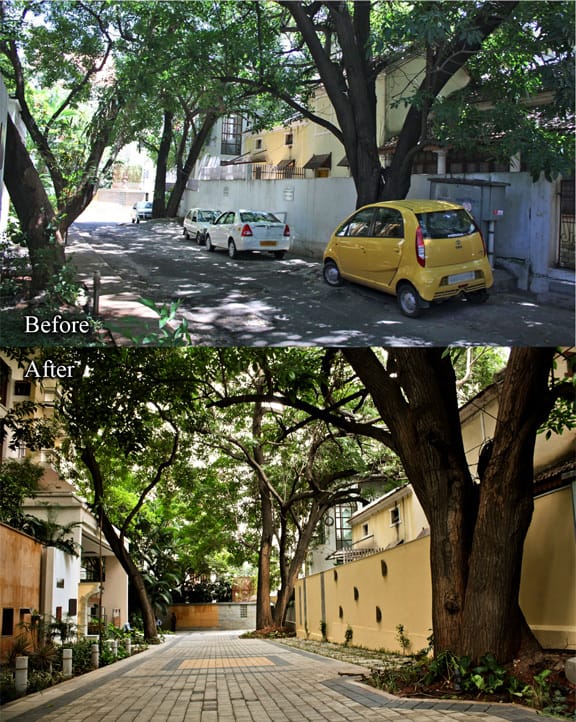
Museum Cross Road, a residential street at the heart of Bengaluru, used to be a road like many others in the neighbourhood. The maintenance was neglected. The old pavement was uneven, and tree roots were breaking through, cracking the pavement and creating bumps. It was an eyesore. Worse than that, it posed a danger to the residents. There weren’t even street lights to illuminate the road at night.
This was the fate, until residents of the street, which is colloquially known as Museum Cross Road because it is located just off of Museum Road, decided enough was enough. The city government could not be relied upon. The residents of Museum Cross Road chose to act alone.
Hurdles couldn’t stop them
“When you’re coming home in the evening, and falling into a hole that’s almost a foot deep, and six and seven years later it happens again and again,” says Shivika Singh, a resident of the street, “you do decide something needs to be done.”
There was a need for the renovations, but the process was not free of challenges. At first, Singh said no one wanted to take charge, and residents were slow to get on board. The core group of four residents, including Rajesh Manglani, had to encourage others to become involved.
Manglani said people resisted, particularly because they did not want to contribute financially. The residents completely funded the renovations using their own financial resources.
Once people were more involved, some offered a suggestion to simply pave over the street with concrete. “We had a different vision,” Manglani says. “We wanted to create something that gave us a wow factor.”
Manglani said it was not easy. They had to get government permission, hire architects, come up with planning, and schedule the construction work so it didn’t inconvenience anyone or hinder traffic movement, among other difficulties. The road is technically a public road owned by the city, so they had to get BBMP approval, a process mired in bureaucracy.
The process took more than a year. Total cost incurred was Rs 25,71,752.

Project becomes more concrete
Arun Balan and Shehla Hussain work for the architecture firm, Balan and Nambian Architects, and were involved in planning the designs for the street renovation. They were brought on the projects after the residents decided needed to hire architects. Balan describes the project as an “urban intervention.”
Instead of pavement, they used concrete cobbles, which allow rainwater to soak into the ground according to Balan. Parking spaces were marked by square stones with leaf imprints, and arches with lanterns show where each doorway is.
“With every street you have to see what it needs, and what it needs to discourage, and what it needs to encourage,” Hussain said.
The architects said they weren’t sure their model could be copied exactly, but more of these initiatives in small stretches of road could work, and could gain momentum if more of these projects happen. Balan stressed that it is possible for other projects like this to succeed.
“We can be hopeful that people can learn from this experience,” he said.
As far as government intervention goes, Balan said he doesn’t know what parameters need to be set for the government to take up initiatives to improve street design and other projects. But he said MG Road and Brigade Road used to look like Church Street with no pavements, and the government finally woke up to the need for renovation.
“It was a big thrill for us to just walk on a street where you weren’t going to trip and fall,” he said.
The final result
Unlike the planning process, the construction was completed quickly. It was finished within two or three months, a result of good planning according to Singh.
“I think there is a lot that can be done, but a single person cannot do it,” Manglani said. “If a community gets together, a lot can be achieved.”
Manglani said it is possible for citizens to take on similar projects, but it sadly might not happen. He said they need to be prepared to invest a lot of time, and deal with headaches.
“We stuck to what we wanted to do, and we achieved what you see,” Manglani said. “We feel it’s a huge project that we accomplished.”
Singh added, “Happy and proud, for sure.”
Six steps to success
The well-organised project followed these six steps.
1) Residents commissioned a survey of the street. This was a simple but important step to make sure the road is properly renovated and does not interfere with existing structures.
2) Architects proposed a design based on conversations with residents. A dialogue between residents and architects was essential to ensure the project was built to their specification
3) BBMP sanctions the project. This was required, as the renovation had to be done within existing regulations.
4) Project planning and phasing: Strategies were chalked out to fit the unique situation. Construction had to allow mobility of residents.
5) Residents found a reliable contractor, and kept open a channel of communication. The contractor had set up a contact person for a quick and clear line of communication for any concerns.
6) Residents maintained the documentation of fees associated with the work for easy reference so others can see what has been done.
Related Articles
Mile by mile, they’ll beautify Bengaluru
The Bangalore Underground Project: Dance, sing, paint – right under K R Circle!
2K run, history, song and dance mark Underground Festival at K R Circle
New auto offer at the heart of Bengaluru: Visit two shops and get a low-cost ride!
Nice! This would be a useful reference project since Bangalore is full of potholes. The finished roads are simply great! Could you give an idea of the approximate expenses incurred? Also: did/will BBMP contribute monetarily?
Reposting a comment by Amit Bansal on our Google+ page (plus.google.com/+citizenmatters): “This is absolutely amazing! Wow, what a transformation. But the more that citizen action like this gathers momentum, the more I feel that we are not making taxes work, and holding govt bodies accountable”.
‘@Amit Kumar, it costed around 25L, as eloborated in the article. This included some extra features and work required by the residents as well as any miscellaneous hiccups along the construction. It was completely funded by the residents.
@ Amit Bansal (via. Ganga) our hope is that model projects like this could help citizens put pressure on the BBMP to fund more of these projects via local architects.